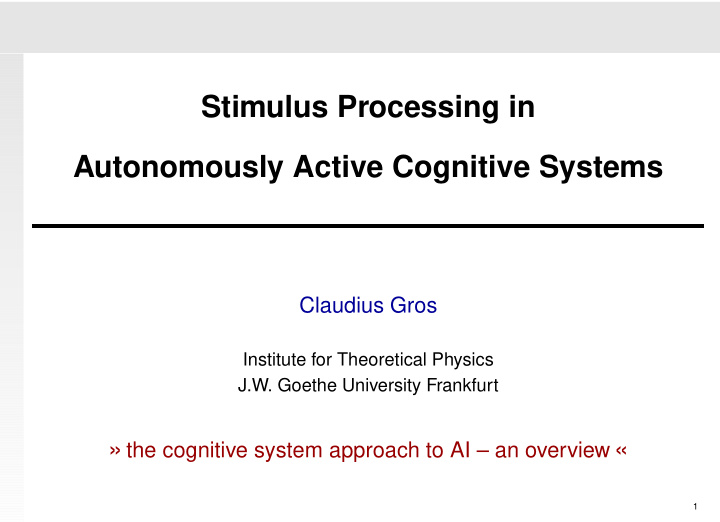



Stimulus Processing in Autonomously Active Cognitive Systems Claudius Gros Institute for Theoretical Physics J.W. Goethe University Frankfurt » the cognitive system approach to AI – an overview « 1
pitfalls of traditional AI ‘mainstream AI will not lead to human-level cognitive systems (CS)’ • the architectural conundrum AI: algorithmic optimization CS: cognitive capabilities emergent from universal principles • the motivational problem AI: tasks given by external supervisor CS: diffusive emotional control 2
the architectural conundrum cognitive systems - universal principles • universal time prediction tasks (Elman) ⊲ environmental model building ⊲ unsupervised generation of abstract concepts • behavioral complexity optimization (Edelman, Sporns, ...) ⊲ spontaneous explorative strategies • autonomous internal dynamics (Gros) ⊲ semantic learning: unsupervised, developmental .... are all applicable for a wide range of environments C. Gros “Cognitive computation with autonomously active neural networks: An emerging field” , Cognitive Computation 1 , 77 (2009) 3
the motivational problem cognitive systems as living & embedded dynamical systems • proprioceptual survival parameters ⊲ blood pressure, blood sugar level, pain signals, ... ⊲ ‘survival instinct’ • diffusive emotional control - neuromodulators ⊲ signaling: novelty, learning, ... ⊲ diffusive: acts on entire neural ensembles ⊲ meta-learning: thresholds, synaptic plasticities, ... ⊲ evolved from neutral homeostatic regulation C. Gros “Emotions, diffusive emotional control and the motivational problem for autonomous cognitive systems” , Handbook of Research on Synthetic Emotions and Sociable Robotics: New Applications in Affective Computing and Artificial Intelligence , Vallverdí, Casacuberta (Eds.) (2009, in print) 4
information processing vs. diffusive control Frankfurt Cognitive System Platform module A cognitive diffusive processing control ⊲ full online architectural configurability diffusive emotional signaling interactions ⊲ learning exclusively module B : unsupervised information cognitive diffusive flow processing control : online status current status signals module C module D ⊲ autonomous dynamics cognitive diffusive diffusive cognitive processing control control processing : transient states : stimulus processing : novelty signals » emergent cognitive capability: non-linear ICA « 5
correlations: internal vs. external? self−generated internal dynamics neural activity time sensory data input stream 6
coupling to sensory input self-generated internal dynamics ⊲ dHan (dense homogeneous associative network) (0,1,2) (2,3,4) (4,5,6) (6,7) (7,8,9,10) autonomous dHan dynamics sensory input input input data stream ⊲ unrelated to internal dynamics 7
learning during sensible periods competition internal dynamics ⇔ sensory input [A] [B] [C] [D] [E] [F] 1 0.8 x i 0.6 0.4 0.2 activities 0 time 1200 1400 1 r i 0 growth rates -1 1200 1400 1 ∆ r i 0.5 0 sensory input 1200 1400 8
clique receptive fields C C C C C C C C C C 2 7 5 4 9 1 8 3 6 10 0.8 0.7 0.6 0.5 0.4 0.3 0.2 0.1 0.0 −0.1 −0.2 9
cognitive computation • a new journal Introducing Cognitive Computation Editor-in-Chief: Amir Hussain, PhD University of Stirling, Scotland, UK • interdisciplinary Honorary Editor: Igor Aleksander, PhD Imperial College, London, UK Advisory Board Chair: John Taylor, PhD King’s College, London, UK Volume 1, Issue 1, March 2009 • beyond neurobiology, ISSN: 1866-9956 (print) 1866-9964 (online) applications New for 2009 Cognitive Computation is an international, peer-reviewed, interdisciplinary journal that publishes cutting-edge articles describing original basic and applied work involving biologically- inspired computational accounts of all aspects of natural and artificial cognitive systems. It provides a new platform for the dissemination of research, current practices and future trends in the emerging discipline of cognitive computation that bridges the gap between life sciences, social sciences, engineering, physical and mathematical sciences, and • http://www.springer.com/12559 humanities. Its main purpose is to establish a forum for bringing different scientific communities together to discuss key issues and challenges in the emerging area of cognitive computation and to promote an interdisciplinary understanding of the diverse topics, including those related to perception, action, attention, learning and memory, decision making, language processing, communication, reasoning, problem solving, and consciousness aspects of cognition. Cognitive Computation considers original contributions using theoretical, computational, experimental and integrative studies in cognitive systems, including (but not limited to): artificial intelligence, neural networks, cognitive neuromorphic engineering and other hardware implementations, cognitive robotics, autonomous cognitive systems, neuroscience nanotechnology, self-organizing, swarm and immune systems, complex systems and control theory, and computational • Springer, starting 2009 cognitive neuroscience, as well as submissions focusing on the development of latest research into practical applications. for submission and further information, visit us online: springer.com/12559 10
graduate level textbook • The small world phenomenon in social and scale-free networks • Phase transitions and self-organized criticality in adaptive systems • Life at the edge of chaos and coevolutionary avalanches resulting from the unfolding of all living • Living dynamical systems and emotional diffusive control within cognitive system theory (Springer, 2008) 11
Frankfurt Cognitive System Platform meta network of neural networks • JAVA platform: class diagram • flexibility: full on-the-fly architectural reconfiguration • GUI (graphical user inferface): auto adaptive 12
Recommend
More recommend